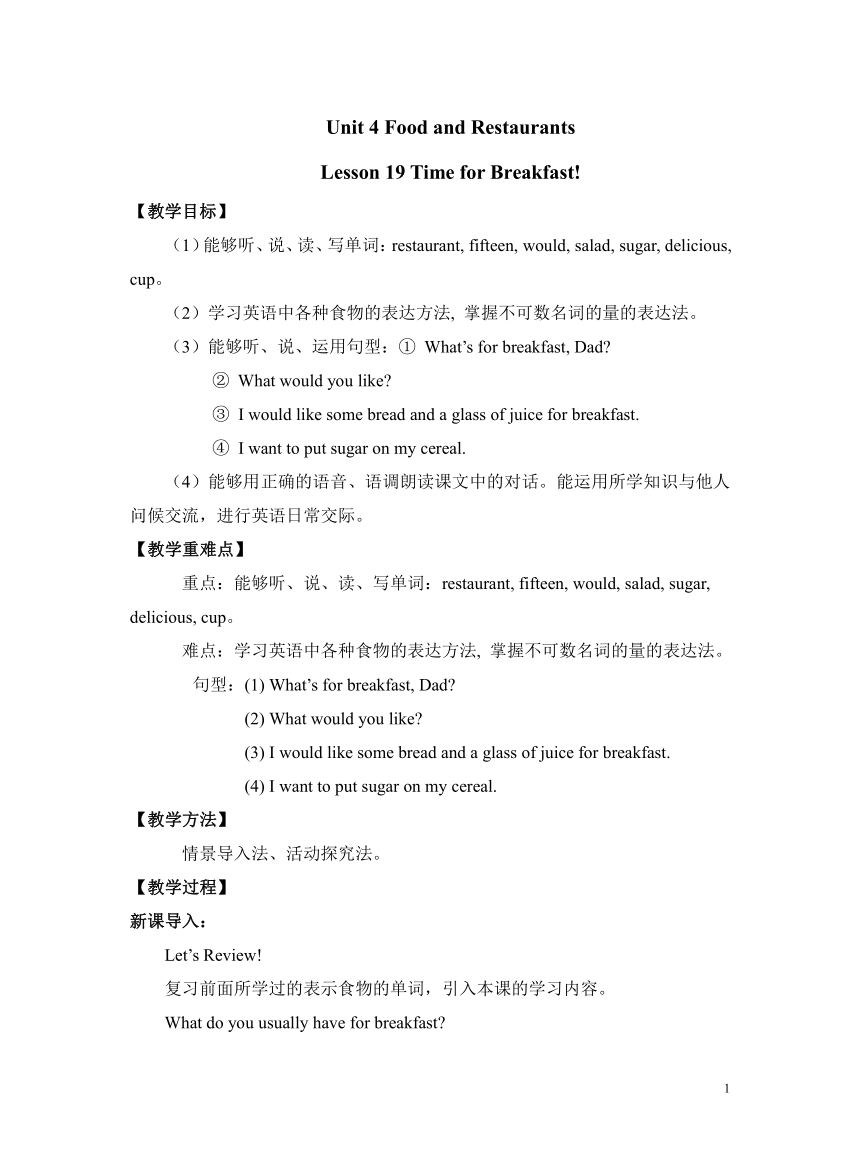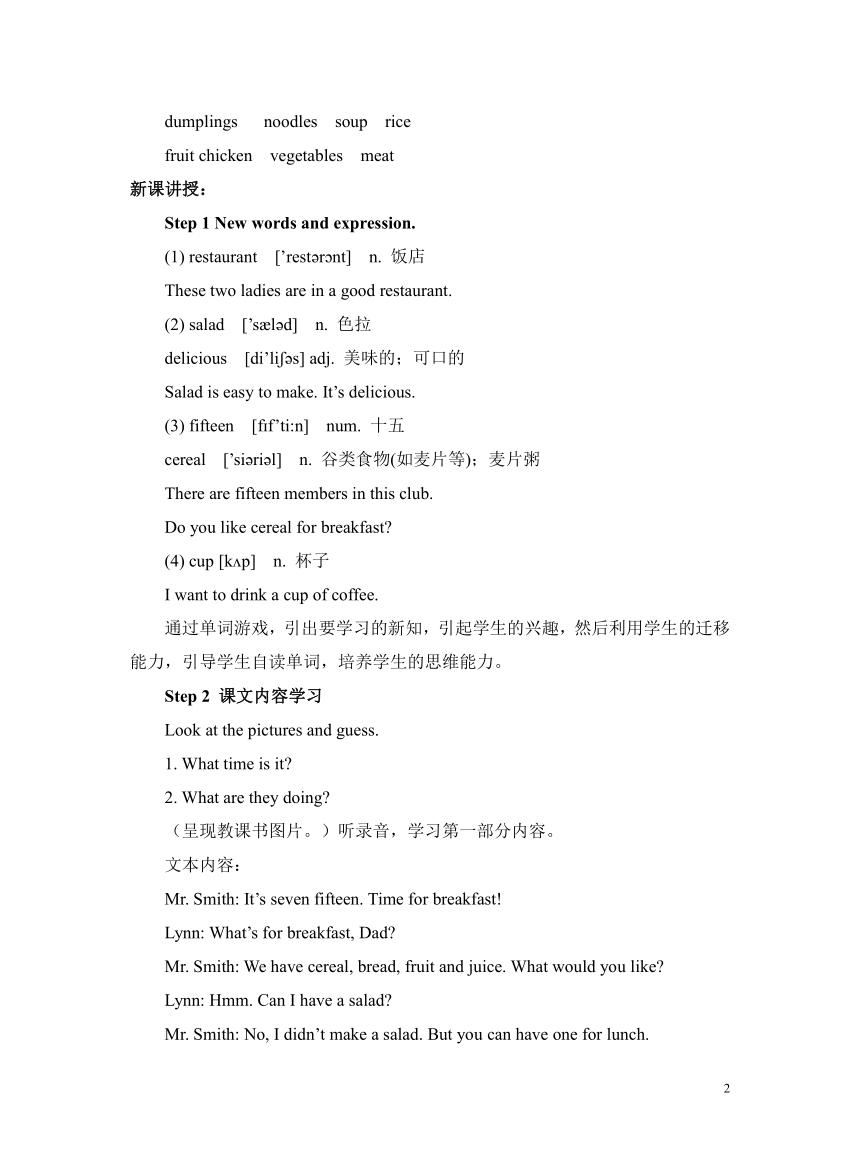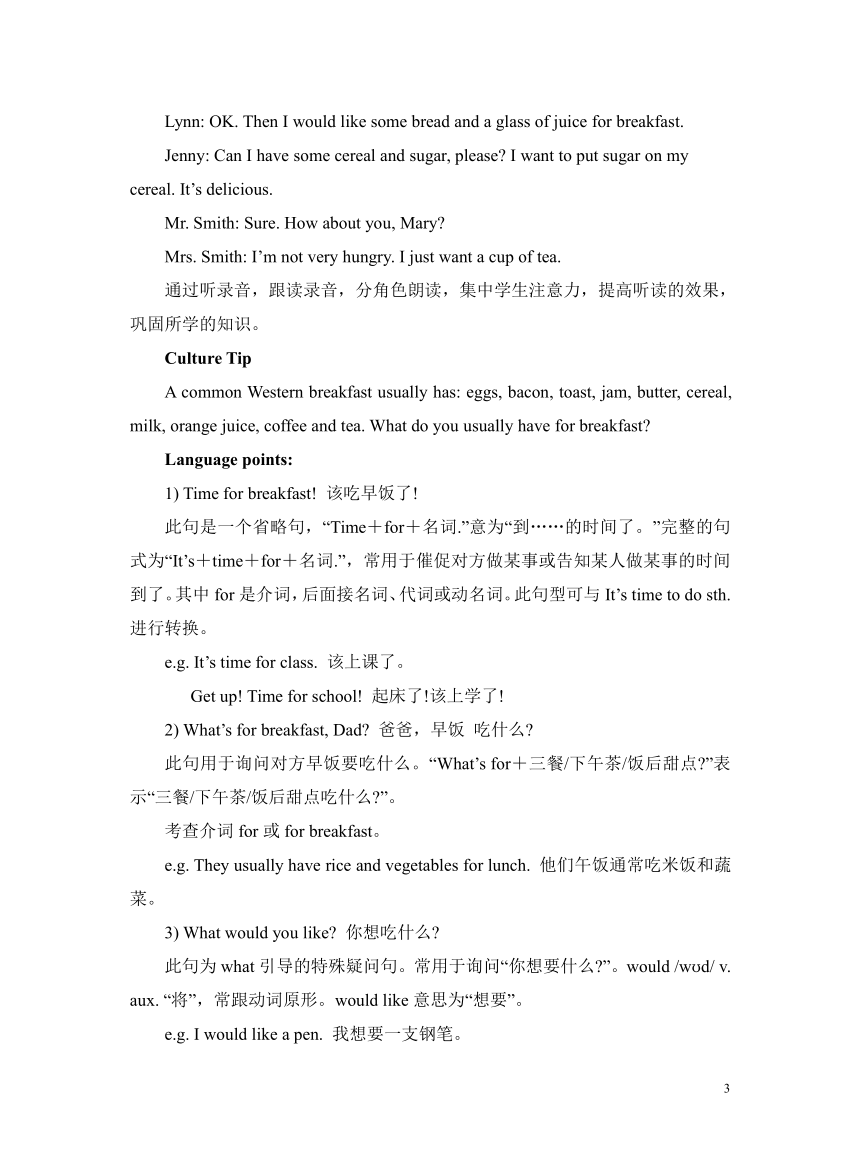冀教版英语七年级上册 Unit 4 Food and Restaurants Lesson 19 Time for Breakfast 教案
文档属性
| 名称 | 冀教版英语七年级上册 Unit 4 Food and Restaurants Lesson 19 Time for Breakfast 教案 |  | |
| 格式 | docx | ||
| 文件大小 | 19.9KB | ||
| 资源类型 | 教案 | ||
| 版本资源 | 冀教版 | ||
| 科目 | 英语 | ||
| 更新时间 | 2023-09-06 23:09:34 | ||
图片预览



文档简介
Unit 4 Food and Restaurants
Lesson 19 Time for Breakfast!
【教学目标】
(1)能够听、说、读、写单词:restaurant, fifteen, would, salad, sugar, delicious, cup。
(2)学习英语中各种食物的表达方法, 掌握不可数名词的量的表达法。
(3)能够听、说、运用句型:① What’s for breakfast, Dad
② What would you like
③ I would like some bread and a glass of juice for breakfast.
④ I want to put sugar on my cereal.
(4)能够用正确的语音、语调朗读课文中的对话。能运用所学知识与他人问候交流,进行英语日常交际。
【教学重难点】
重点:能够听、说、读、写单词:restaurant, fifteen, would, salad, sugar, delicious, cup。
难点:学习英语中各种食物的表达方法, 掌握不可数名词的量的表达法。
句型:(1) What’s for breakfast, Dad
(2) What would you like
(3) I would like some bread and a glass of juice for breakfast.
(4) I want to put sugar on my cereal.
【教学方法】
情景导入法、活动探究法。
【教学过程】
新课导入:
Let’s Review!
复习前面所学过的表示食物的单词,引入本课的学习内容。
What do you usually have for breakfast
dumplings noodles soup rice
fruit chicken vegetables meat
新课讲授:
Step 1 New words and expression.
(1) restaurant [’rest r nt] n. 饭店
These two ladies are in a good restaurant.
(2) salad [’s l d] n. 色拉
delicious [di’li s] adj. 美味的;可口的
Salad is easy to make. It’s delicious.
(3) fifteen [f f’ti:n] num. 十五
cereal [’si ri l] n. 谷类食物(如麦片等);麦片粥
There are fifteen members in this club.
Do you like cereal for breakfast
(4) cup [k p] n. 杯子
I want to drink a cup of coffee.
通过单词游戏,引出要学习的新知,引起学生的兴趣,然后利用学生的迁移能力,引导学生自读单词,培养学生的思维能力。
Step 2 课文内容学习
Look at the pictures and guess.
1. What time is it
2. What are they doing
(呈现教课书图片。)听录音,学习第一部分内容。
文本内容:
Mr. Smith: It’s seven fifteen. Time for breakfast!
Lynn: What’s for breakfast, Dad
Mr. Smith: We have cereal, bread, fruit and juice. What would you like
Lynn: Hmm. Can I have a salad
Mr. Smith: No, I didn’t make a salad. But you can have one for lunch.
Lynn: OK. Then I would like some bread and a glass of juice for breakfast.
Jenny: Can I have some cereal and sugar, please I want to put sugar on my cereal. It’s delicious.
Mr. Smith: Sure. How about you, Mary
Mrs. Smith: I’m not very hungry. I just want a cup of tea.
通过听录音,跟读录音,分角色朗读,集中学生注意力,提高听读的效果,巩固所学的知识。
Culture Tip
A common Western breakfast usually has: eggs, bacon, toast, jam, butter, cereal, milk, orange juice, coffee and tea. What do you usually have for breakfast
Language points:
1) Time for breakfast! 该吃早饭了!
此句是一个省略句,“Time+for+名词.”意为“到……的时间了。”完整的句式为“It’s+time+for+名词.”,常用于催促对方做某事或告知某人做某事的时间到了。其中for是介词,后面接名词、代词或动名词。此句型可与It’s time to do sth. 进行转换。
e.g. It’s time for class. 该上课了。
Get up! Time for school! 起床了!该上学了!
2) What’s for breakfast, Dad 爸爸,早饭 吃什么
此句用于询问对方早饭要吃什么。“What’s for+三餐/下午茶/饭后甜点 ”表示“三餐/下午茶/饭后甜点吃什么 ”。
考查介词for或for breakfast。
e.g. They usually have rice and vegetables for lunch. 他们午饭通常吃米饭和蔬菜。
3) What would you like 你想吃什么
此句为what引导的特殊疑问句。常用于询问“你想要什么 ”。would /w d/ v. aux. “将”,常跟动词原形。would like意思为“想要”。
e.g. I would like a pen. 我想要一支钢笔。
would like意为“想;想要”,相当于want,没有人称和数的变化。
would like的用法:
(1) 对于“Would you like sth. ”提出的建议或邀请用“Yes, please.”;否定回答用“No, thanks/thank you.”。
(2) 对于“Would you like to do sth. ”的肯定回答为“Yes/Sure, I’d like/love to.”;否定回答为“I’d like/love to, but ...”。
e.g. —Would you like to go shopping with me
你想和我一起去购物吗
—I’d like to, but I have to do my homework.
我想去,但是我得做家庭作业。
4) delicious / d l s/ adj. 美味的,可口的。
可放在连系动词后作表语,也可放在名词前作定语。
e.g. We like the delicious dumplings very much.
我们非常喜欢这些美味的饺子。
Task: Listen to Part 1. Fill in the blanks.
Step 3 Let’s Do It!
1. Listen and fill in the blanks.
2. What would they like for breakfast Read the lesson and fill in the table.
3. Look at the pictures and fill in the blanks.
4. Work in pairs. What would you like for breakfast, lunch or supper Make up a dialogue.
Role play
1. Role play the conversation in groups;
2. Role play the conversation in front of the class.
课堂练习:
一、词语运用
1. Salad is d . I like it for breakfast.
2. I’d like some (糖).
3. W you like some cereal
4. I am hungry. How (be) you
5. Here are (十五) crayons on the desk.
二、单项选择
1. It’s time ________ class. Let’s go into the classroom.
A. to B. of C. for D. In
2. —Would you like to play basketball with us this afternoon
—________, but my mother is ill.
A. I don’t care B. It’s very nice of you
C. Of course not D. My pleasure
3. Would you ________ this picture ________ the wall
A. put; on B. to put; on C. put; over D. put; in
4. What’s ________ lunch
A. in B. on C. for D. with
三、按要求完成各小题
1. lunch, is, for, what (连词成句)
________________________________________
2. Time to have supper. (改为同义句)
________________________________________.
3. Do you want some apples (改为同义句)
________________________________________
4. Would you like a cup of tea (作肯定回答)
_________________________________________.
5. put, desks, the, bags, their, students, the, on (连词成句)
________________________________________.
课堂小结:
T: What did you learn about this lesson
学生自由说,教师总结。
语言知识:
1) 识记以下单词: restaurant, fifteen, would, salad, sugar, delicious, cup。
2) 掌握短语及句型: ① What’s for breakfast, Dad
② What would you like
③ I would like some bread and a glass of juice for breakfast.
④ I want to put sugar on my cereal.
语言技能:
1)能运用所学知识与他人问候交流。
2)听懂并能进行英语日常交际。。
将本节课所学的知识进行归纳,帮助学生理解和记忆,巩固提升本课时所学的知识。
作业布置:
完成配套课后练习。
【板书设计】
Lesson 19 Time for Breakfast!
restaurant, fifteen, would, salad, sugar, delicious, cup, would like,
make a salad, some bread, a glass of juice, how about, a cup of tea
(1) What’s for breakfast, Dad
(2) What would you like
(3) I would like some bread and a glass of juice for breakfast.
(4) I want to put sugar on my cereal.
【课后反思】
本课时的教学内容是冀教版七年级上册英语第四单元的第一课时, 重点在于引导学生理解语境, 从表示早餐的词开始, 自然地导入谈论早餐的饮食的话题。以如何就餐作为任务引起学生的听说兴趣, 训练学生的听力和口语表达能力。利用动作、手势和图片学习英语单词, 同时在对话中反复运用新学的单词和短语。因此, 教师可以将知识目标定为掌握本课时新出现的词和短语, 询问别人的喜好和表达自己最喜欢的饮食的句型。
1
Lesson 19 Time for Breakfast!
【教学目标】
(1)能够听、说、读、写单词:restaurant, fifteen, would, salad, sugar, delicious, cup。
(2)学习英语中各种食物的表达方法, 掌握不可数名词的量的表达法。
(3)能够听、说、运用句型:① What’s for breakfast, Dad
② What would you like
③ I would like some bread and a glass of juice for breakfast.
④ I want to put sugar on my cereal.
(4)能够用正确的语音、语调朗读课文中的对话。能运用所学知识与他人问候交流,进行英语日常交际。
【教学重难点】
重点:能够听、说、读、写单词:restaurant, fifteen, would, salad, sugar, delicious, cup。
难点:学习英语中各种食物的表达方法, 掌握不可数名词的量的表达法。
句型:(1) What’s for breakfast, Dad
(2) What would you like
(3) I would like some bread and a glass of juice for breakfast.
(4) I want to put sugar on my cereal.
【教学方法】
情景导入法、活动探究法。
【教学过程】
新课导入:
Let’s Review!
复习前面所学过的表示食物的单词,引入本课的学习内容。
What do you usually have for breakfast
dumplings noodles soup rice
fruit chicken vegetables meat
新课讲授:
Step 1 New words and expression.
(1) restaurant [’rest r nt] n. 饭店
These two ladies are in a good restaurant.
(2) salad [’s l d] n. 色拉
delicious [di’li s] adj. 美味的;可口的
Salad is easy to make. It’s delicious.
(3) fifteen [f f’ti:n] num. 十五
cereal [’si ri l] n. 谷类食物(如麦片等);麦片粥
There are fifteen members in this club.
Do you like cereal for breakfast
(4) cup [k p] n. 杯子
I want to drink a cup of coffee.
通过单词游戏,引出要学习的新知,引起学生的兴趣,然后利用学生的迁移能力,引导学生自读单词,培养学生的思维能力。
Step 2 课文内容学习
Look at the pictures and guess.
1. What time is it
2. What are they doing
(呈现教课书图片。)听录音,学习第一部分内容。
文本内容:
Mr. Smith: It’s seven fifteen. Time for breakfast!
Lynn: What’s for breakfast, Dad
Mr. Smith: We have cereal, bread, fruit and juice. What would you like
Lynn: Hmm. Can I have a salad
Mr. Smith: No, I didn’t make a salad. But you can have one for lunch.
Lynn: OK. Then I would like some bread and a glass of juice for breakfast.
Jenny: Can I have some cereal and sugar, please I want to put sugar on my cereal. It’s delicious.
Mr. Smith: Sure. How about you, Mary
Mrs. Smith: I’m not very hungry. I just want a cup of tea.
通过听录音,跟读录音,分角色朗读,集中学生注意力,提高听读的效果,巩固所学的知识。
Culture Tip
A common Western breakfast usually has: eggs, bacon, toast, jam, butter, cereal, milk, orange juice, coffee and tea. What do you usually have for breakfast
Language points:
1) Time for breakfast! 该吃早饭了!
此句是一个省略句,“Time+for+名词.”意为“到……的时间了。”完整的句式为“It’s+time+for+名词.”,常用于催促对方做某事或告知某人做某事的时间到了。其中for是介词,后面接名词、代词或动名词。此句型可与It’s time to do sth. 进行转换。
e.g. It’s time for class. 该上课了。
Get up! Time for school! 起床了!该上学了!
2) What’s for breakfast, Dad 爸爸,早饭 吃什么
此句用于询问对方早饭要吃什么。“What’s for+三餐/下午茶/饭后甜点 ”表示“三餐/下午茶/饭后甜点吃什么 ”。
考查介词for或for breakfast。
e.g. They usually have rice and vegetables for lunch. 他们午饭通常吃米饭和蔬菜。
3) What would you like 你想吃什么
此句为what引导的特殊疑问句。常用于询问“你想要什么 ”。would /w d/ v. aux. “将”,常跟动词原形。would like意思为“想要”。
e.g. I would like a pen. 我想要一支钢笔。
would like意为“想;想要”,相当于want,没有人称和数的变化。
would like的用法:
(1) 对于“Would you like sth. ”提出的建议或邀请用“Yes, please.”;否定回答用“No, thanks/thank you.”。
(2) 对于“Would you like to do sth. ”的肯定回答为“Yes/Sure, I’d like/love to.”;否定回答为“I’d like/love to, but ...”。
e.g. —Would you like to go shopping with me
你想和我一起去购物吗
—I’d like to, but I have to do my homework.
我想去,但是我得做家庭作业。
4) delicious / d l s/ adj. 美味的,可口的。
可放在连系动词后作表语,也可放在名词前作定语。
e.g. We like the delicious dumplings very much.
我们非常喜欢这些美味的饺子。
Task: Listen to Part 1. Fill in the blanks.
Step 3 Let’s Do It!
1. Listen and fill in the blanks.
2. What would they like for breakfast Read the lesson and fill in the table.
3. Look at the pictures and fill in the blanks.
4. Work in pairs. What would you like for breakfast, lunch or supper Make up a dialogue.
Role play
1. Role play the conversation in groups;
2. Role play the conversation in front of the class.
课堂练习:
一、词语运用
1. Salad is d . I like it for breakfast.
2. I’d like some (糖).
3. W you like some cereal
4. I am hungry. How (be) you
5. Here are (十五) crayons on the desk.
二、单项选择
1. It’s time ________ class. Let’s go into the classroom.
A. to B. of C. for D. In
2. —Would you like to play basketball with us this afternoon
—________, but my mother is ill.
A. I don’t care B. It’s very nice of you
C. Of course not D. My pleasure
3. Would you ________ this picture ________ the wall
A. put; on B. to put; on C. put; over D. put; in
4. What’s ________ lunch
A. in B. on C. for D. with
三、按要求完成各小题
1. lunch, is, for, what (连词成句)
________________________________________
2. Time to have supper. (改为同义句)
________________________________________.
3. Do you want some apples (改为同义句)
________________________________________
4. Would you like a cup of tea (作肯定回答)
_________________________________________.
5. put, desks, the, bags, their, students, the, on (连词成句)
________________________________________.
课堂小结:
T: What did you learn about this lesson
学生自由说,教师总结。
语言知识:
1) 识记以下单词: restaurant, fifteen, would, salad, sugar, delicious, cup。
2) 掌握短语及句型: ① What’s for breakfast, Dad
② What would you like
③ I would like some bread and a glass of juice for breakfast.
④ I want to put sugar on my cereal.
语言技能:
1)能运用所学知识与他人问候交流。
2)听懂并能进行英语日常交际。。
将本节课所学的知识进行归纳,帮助学生理解和记忆,巩固提升本课时所学的知识。
作业布置:
完成配套课后练习。
【板书设计】
Lesson 19 Time for Breakfast!
restaurant, fifteen, would, salad, sugar, delicious, cup, would like,
make a salad, some bread, a glass of juice, how about, a cup of tea
(1) What’s for breakfast, Dad
(2) What would you like
(3) I would like some bread and a glass of juice for breakfast.
(4) I want to put sugar on my cereal.
【课后反思】
本课时的教学内容是冀教版七年级上册英语第四单元的第一课时, 重点在于引导学生理解语境, 从表示早餐的词开始, 自然地导入谈论早餐的饮食的话题。以如何就餐作为任务引起学生的听说兴趣, 训练学生的听力和口语表达能力。利用动作、手势和图片学习英语单词, 同时在对话中反复运用新学的单词和短语。因此, 教师可以将知识目标定为掌握本课时新出现的词和短语, 询问别人的喜好和表达自己最喜欢的饮食的句型。
1
同课章节目录
- Unit 1 School and friends
- Lesson 1 Hello!
- Lesson 2 Teacher and Students
- Lesson 3 Welcome to Our School
- Lesson 4 What Is It?
- Lesson 5 May I Have a Book?
- Lesson 6 Things for School
- Unit 2 Colours and Clothes
- Lesson 7 Jenny's New Skirt
- Lesson 8 Danny's Favourit Colou
- Lesson 9 Whose Coat Is This?
- Lesson 10 Clothes for a Cold Day
- Lesson 11 Clothes around the World
- Lesson 12 Let's Go Shopping!
- Unit 3 Body Parts and Feelings
- Lesson 13 Body Parts
- Lesson 14 Colours and Feelings
- Lesson 15 Tall or Short
- Lesson 16 Happy or Sad
- Lesson 17 Seeing a Docto
- Lesson 18 We All Look Different!
- Unit 4 Food and Restaurants
- Lesson 19 Time for Breakfast!
- Lesson 20 I Like the Supermarket!
- Lesson 21 At the Market
- Lesson 22 In the Restaurant
- Lesson 23 The Corner Store
- Lesson 24 Eat Good Food!
- Unit 5 Family and Home
- Lesson 25 Jenny's Family
- Lesson 26 Li Ming's Family
- Lesson 27 Danny at Home
- Lesson 28 A Family Picnic
- Lesson 29 A Birthday Card
- Lesson 30 Grandma's Birthday Party
- Unit 6 Let's Go!
- Lesson 31 Let's Go to the Bookstore!
- Lesson 32 At the Supermarket
- Lesson 33 Let's Go to the Zoo!
- Lesson 34 On the Farm
- Lesson 35 Let's Go to the Museum!
- Lesson 36 Let's Go to the Movie Theatre!
- Unit 7 Days and Months
- Lesson 37 Seasons and Weathe
- Lesson 38 Nick's Busy Month
- Lesson 39 A Class Calenda
- Lesson 40 When Is Your Birthday?
- Lesson 41 Holidays
- Lesson 42 Happy Holidays!
- Unit 8 Countries around the world
- Lesson 43 Directions
- Lesson 44 Jack's Goodbye Party
- Lesson 45 China
- Lesson 46 Canada and the U.S.
- Lesson 47 The U.K. and Australia
- Lesson 48 English-Speaking Countries
